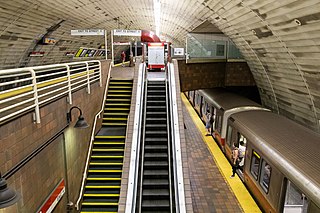
Porter station is a Massachusetts Bay Transportation Authority (MBTA) transit station in Cambridge, Massachusetts. It serves the Red Line rapid transit line, the MBTA Commuter Rail Fitchburg Line, and several MBTA bus lines. Located at Porter Square at the intersection of Massachusetts and Somerville Avenues, the station provides rapid transit access to northern Cambridge and the western portions of Somerville. Porter is 14 minutes from Park Street on the Red Line, and about 10 minutes from North Station on commuter rail trains. Several local MBTA bus routes also stop at the station.

North Station is a commuter rail and intercity rail terminal station in Boston, Massachusetts. It is served by four MBTA Commuter Rail lines – the Fitchburg Line, Haverhill Line, Lowell Line, and Newburyport/Rockport Line – and the Amtrak Downeaster intercity service. The concourse is located under the TD Garden arena, with the platforms extending north towards drawbridges over the Charles River. The eponymous subway station, served by the Green Line and Orange Line, is connected to the concourse with an underground passageway.
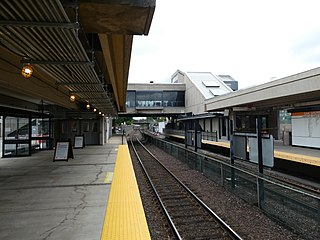
Oak Grove station is a Massachusetts Bay Transportation Authority (MBTA) intermodal transit station in the northern section of Malden, Massachusetts, just south of the Melrose border. It is the northern terminus of the rapid transit Orange Line and a stop on the Haverhill Line commuter rail service. The accessible station has a 788-space park and ride lot and is served by four MBTA bus routes.

Malden Center station is a Massachusetts Bay Transportation Authority (MBTA) intermodal transit station in Malden, Massachusetts. Located on an elevated grade above Pleasant Street in downtown Malden, it serves the rapid transit Orange Line and the MBTA Commuter Rail Haverhill Line. The station has one island platform for the two Orange Line tracks and a single side platform for the single commuter rail track. Two busways are used by 13 MBTA bus routes.

The Lowell Line is a railroad line of the MBTA Commuter Rail system, running north from Boston to Lowell, Massachusetts. Originally built as the New Hampshire Main Line of the Boston & Lowell Railroad and later operated as part of the Boston & Maine Railroad's Southern Division, the line was one of the first railroads in North America and the first major one in Massachusetts.

Community College station is a rapid transit station on the MBTA Orange Line in Boston, Massachusetts. It is located in the Charlestown neighborhood off Austin Street near New Rutherford Avenue (MA-99), under the double-decked elevated structure carrying Interstate 93 to the Zakim Bunker Hill Bridge. The station is named for the adjacent Bunker Hill Community College. The station opened in April 1975, replacing the City Square and Thompson Square stations of the Charlestown Elevated. It was made accessible around 2005.
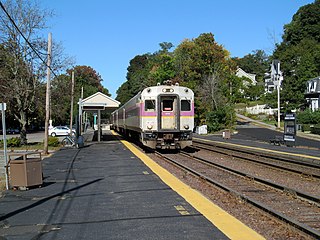
The Haverhill Line is a branch of the MBTA Commuter Rail system, running north from downtown Boston, Massachusetts through the cities and towns of Malden, Melrose, Wakefield, Reading, Wilmington, Andover, North Andover, Lawrence, and Haverhill.
The Haymarket North Extension is a section of the Massachusetts Bay Transportation Authority's rapid transit Orange Line which currently constitutes the northern section of the line. It runs from North Station through an underground crossing of the Charles River, then along the Haverhill Line right-of-way to Oak Grove station in Malden, Massachusetts. Built to replace the Charlestown Elevated and originally intended to be extended as far as Reading, it opened in stages between 1975 and 1977.

Haverhill station is an intercity and regional rail station located in downtown Haverhill, Massachusetts, United States. It is served by Amtrak's Downeaster service and the MBTA Commuter Rail Haverhill/Reading Line; it is the northern terminus of MBTA service. Haverhill is one of two major hubs for MVRTA local bus service; the Washington Square Transit Center is located 1⁄5 mile (0.32 km) east of the rail station.

Wyoming Hill station is an MBTA Commuter Rail station on the Haverhill Line, located in Wyoming Square near downtown Melrose, Massachusetts. The station has two low-level side platforms and is not accessible. Wyoming Hill, in addition to the two other commuter rail stops in Melrose, was originally intended to be an extension of the Orange Line further north to Reading, Massachusetts.

Silver Hill station was an MBTA Commuter Rail Fitchburg Line station in Weston, Massachusetts, United States. The station had a small shelter, parking area, and a gravel boarding area; it was not accessible. It was the least-used station in the entire MBTA system in 2018, with an average of just eleven daily boardings. Silver Hill station opened in 1844 as one of the original stops on the Fitchburg Railroad. The Boston and Maine Railroad unsuccessfully attempted to close the station in 1959. It remained in use until its temporary closure by the Massachusetts Bay Transportation Authority (MBTA) in December 2020 due to low ridership and a lack of accessibility, with indefinite closure effective April 2021.

Melrose/Cedar Park station is an MBTA Commuter Rail station located in downtown Melrose, Massachusetts. The station has two low-level platforms serving the two tracks of the Haverhill Line; it is not accessible.
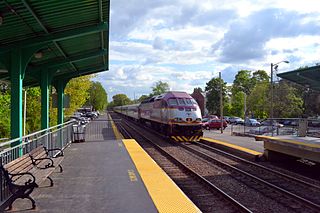
Melrose Highlands station is an MBTA Commuter Rail station on the Haverhill Line located in the Melrose Highlands neighborhood of Melrose, Massachusetts. It is the most used station in the city, and was originally planned to be a station on the cancelled extension of the Orange Line to Reading. The station is accessible.

The Senator Patricia McGovern Transportation Center, also known as the McGovern Transportation Center or simply Lawrence station, is a transit station in Lawrence, Massachusetts. It serves the MBTA Commuter Rail Haverhill Line and Merrimack Valley Regional Transit Authority local bus service. The station, which opened in 2005, is the latest of seven distinct stations located in Lawrence since 1848; it is located in the city's Gateway District.

Andover station is an MBTA Commuter Rail station in Andover, Massachusetts. It serves the Haverhill Line. The station has one platform with a mini-high platform for handicapped accessibility serving one track, while the second track lacks a platform. The previous station building, used from 1907 to 1959, is still extant; it was added to the National Register of Historic Places in 1982 as Third Railroad Station.

Bradford station is an MBTA Commuter Rail station in the Bradford neighborhood of Haverhill, Massachusetts, served by the Haverhill Line. The Haverhill Line's layover yard is located adjacent to the station.

Ayer station is an MBTA Commuter Rail station located off Main Street in the Ayer Main Street Historic District of Ayer, Massachusetts. It serves the Fitchburg Line. There are three tracks through the station, two of which are served by a pair of low-level side platforms, which are not accessible. There is a shelter on the inbound platform.

Greenwood station is an MBTA Commuter Rail station on the Haverhill Line located in the Greenwood neighborhood of Wakefield, Massachusetts. The station consists of two side platforms serving the line's two tracks. The low-level platforms are not accessible.

Wakefield station is an MBTA Commuter Rail station in Wakefield, Massachusetts served by the Haverhill Line. The station has two side platforms, which are not accessible, serving the line's two tracks. The station building, constructed in 1889, was listed on the National Register of Historic Places in 1989 as Wakefield Upper Depot.
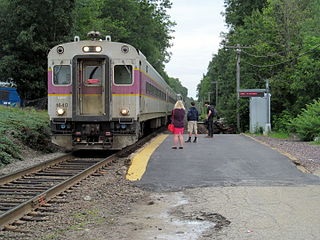
North Wilmington station is an MBTA Commuter Rail station in North Wilmington, Massachusetts. It serves the Haverhill Line, and is located off Middlesex Avenue (Route 62). It has some of the most limited station faculties on the MBTA system - a single short bare platform serving the line's single track at the location, with a small parking lot and single bus shelter for passengers - but is a stop for all trains on the line. North Wilmington station is not accessible.






















